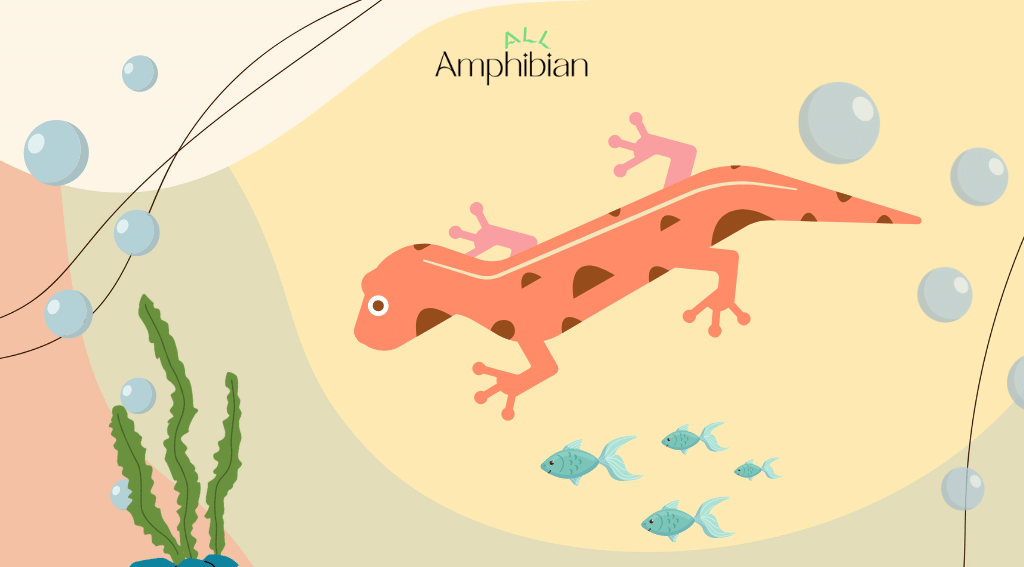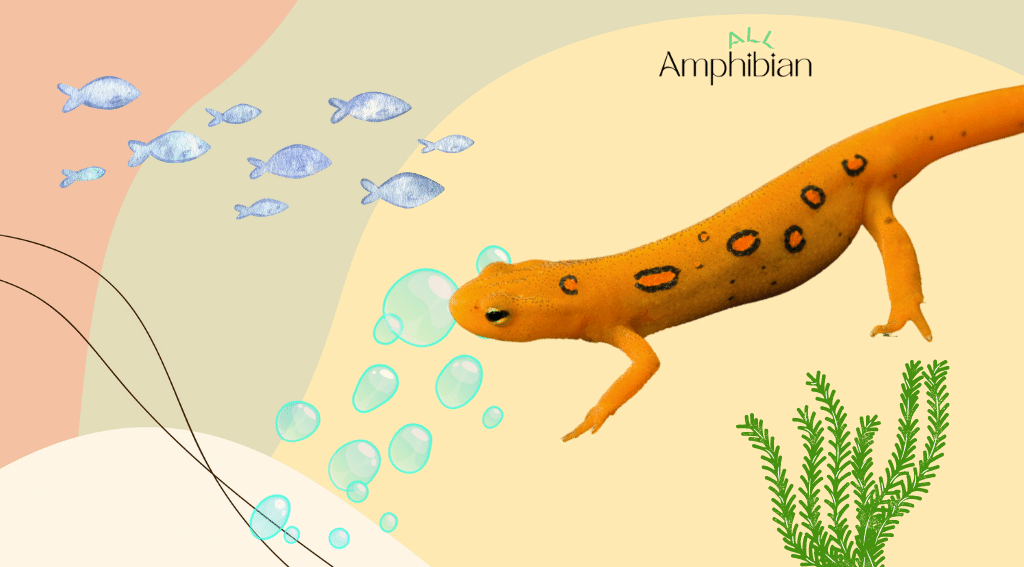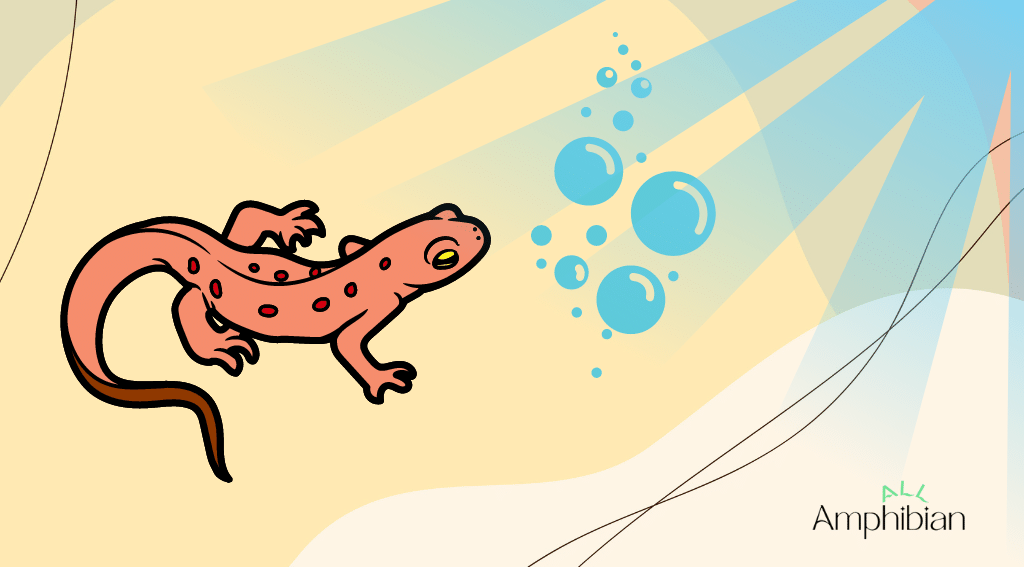How long can newts stay underwater? Newts are amphibians and belong to the salamander family. They are not aquatic creatures, but their life depends on water. They are good swimmers, and we often see them in the water. In this article at All Amphibian, we want to show you how much newts can stay underwater, So stay with us.
How long can newts stay and last underwater?

Newtons are amphibians. But their life is a little different from other amphibians. They belong to the family of salamanders and have a three-stage life. They live in different environments in each of their life stages and have different respiratory systems. Most newts are semi-aquatic, except for a few fully aquatic species.
Like salamanders, they live in humid environments and their life is completely dependent on water. All newts can breathe through their skin. Fully grown newts have lungs and breathe air. Underwater, they can absorb water oxygen through their skin, but this amount of oxygen is not enough for them, and they have to come to the surface of the water to breathe.
Various factors affect how long newts can last underwater. They can stay underwater from 15 minutes to several months. It mostly depends on their body metabolism and their activity level. Some newts hibernate in the depths of lakes where the water is warmer during winter.
Their body metabolism is so low that they can survive underwater for several months. But under normal conditions, they will suffocate if they remain underwater for a long time. It has even been seen that captive newts have drowned in water because the newts will drown if they stay underwater for long enough or if they go deep enough that they cannot return to the water’s surface in time.
How do newts breathe underwater?

Newts are larvae after hatching and look like tadpoles. Newts larvae are aquatic and breathe underwater through their gills. Newt larvae have feather-like gills on both sides of their heads. The appearance of these gills is such that they create a wide surface for absorbing oxygen.
The gills have a wide network of blood vessels with very thin skin. When the water comes in contact with the gills, the oxygen dissolved in the water passes through this membrane and enters the bloodstream, and carbon dioxide also enters the water from the blood in the same way.
Adult newts also can breathe underwater through their skin. Their skin has a very thin membrane. A wide network of blood vessels is close to the surface of their skin. The skin of adult newts acts just like the gills of newts larvae and absorbs oxygen from the water. Newt larvae get all the oxygen they need through their gills and can stay underwater indefinitely. For this reason, they cannot survive outside the water for a long time and will suffocate.
How does Newton’s respiratory system work?
The life of a newt has three stages. In each of these stages, they live in different environments and have different respiratory systems. Most newts lay their eggs in water, and the larvae of the newts are completely aquatic at birth. They have feather-like gills on either side of their heads. Newt larvae get all the oxygen they need through their gills.
After a few weeks to a few months, newt larvae undergo metamorphosis. Their bodies undergo extensive changes. Their gills are absorbed into their bodies, their arms and legs grow, and their lungs are perfected. Then they enter the second stage of their life. At this stage, the newts leave the water. Young newts breathe with their lungs and live on land.
They mostly live in hiding places such as under the leaves and trunks of trees and on the sides of rocks and do not return to the water. Their lungs are not like humans, they do not have a diaphragm like humans, and they cannot take air into their lungs. Newts use a method called gular pumping to breathe air through their lungs.
In this method, they first lower the floor of their mouths, this creates suction, and air enters their mouths through the nostrils. Then the newt closes its nostrils and raises the floor of its mouth. With this, the air is transferred from inside their mouths into their lungs. Then they lower the floor of their mouth again and move air from inside the lungs into the mouth. In the end, they open their nostrils and raise the floor of their mouths and send air out of their mouths.
Newts do all these steps involuntarily in a fraction of a second. Young newts reach full maturity after a few months to a few years. Their bodies grow and get bigger. At this time, they become semi-aquatic creatures and constantly live by the water. At this stage, they breathe through their lungs, but their lungs are not developed like humans and cannot supply the oxygen they need.
For this reason, newts get the rest of the oxygen they need through their skin. So adult newts get the oxygen they need through their skin and lungs. There is a species of newts that spend their youth and adulthood in water, but they also have lungs and can live outside of water. Also, some adult newts have gills. They do not lose their larval characteristics, which are called neoteny, and occur when the conditions for life on the land are unfavorable, and there are good conditions for life in water.

Factors affecting how long newts can stay underwater
As we said, newt larvae have gills and can stay underwater as long as they want. But adult newts are not like that. They absorb the oxygen they need underwater through their skin. Various factors affect their breathing underwater. In favorable conditions, they can even survive underwater for months. Factors affecting the respiration of newts underwater are
- Oxygen amount
The amount of dissolved oxygen in the water has a great effect on the respiration of newts underwater. The more oxygen there is in the water, the easier it is for them to breathe, and they can last longer underwater.
- Water Temperature
The water temperature also has a great effect on the breathing of newts underwater. Cold water has more oxygen than warmer water. Also, newts are cold-blooded creatures, and their body temperature changes with the ambient temperature. For this reason, warm water increases the body’s metabolism. Therefore, the lower the water temperature, the longer the newts can stay underwater.
- Running water
The flow of water also affects the breathing of newts underwater; Because running water contains more oxygen. Oxygen dissolves in contact with water. For this reason, there is more oxygen in running water. In stagnant water, oxygen is present only on the surface of the water, and less oxygen is found in the deeper parts. Therefore, newts can stay longer under running.
- Skin Surface
As we said, newts breathe underwater through their skin. The wider their skin surface, the more oxygen they receive. Some species of newts have a wider skin surface and absorb more oxygen due to having a crest, wide tail, or many wrinkles.
- Metabolism
It can be said that the most important and influential factor in the breathing of newts underwater is the level of activity and metabolism of their bodies. Like humans, newts increase their metabolism when they move. Their heart beats faster and pumps more blood, and the body consumes more oxygen. For this reason, the lower the activity of newts, the lower their body’s metabolism, and less oxygen will be needed.
Some newts species hibernate in the depths of lakes during winter. Normally, they cannot stay underwater for a long time, and their skin does not provide them with the oxygen they need underwater, but in the winter season, they lower their body metabolism so much that with the same amount of oxygen they receive through their skin, they can survive under water for months.
What we learned

Newts are semi-aquatic amphibians whose life consists of three stages. They lay their eggs in water, and newt larvae are completely aquatic when they hatch. They have feather-like gills on both sides of their heads through which they breathe. The gills of newts consist of a network of blood vessels with very thin skin.
Oxygen dissolved in the water passes through the thin membrane of the gills of newt larvae and enters the blood, and carbon dioxide enters the water from the blood in the same way. Newts undergo metamorphosis after passing their larval stage. They lose their gills, and their lungs emerge. In the second stage of their life, young newts leave the water and enter the land.
At this stage, they breathe with their lungs. After a few weeks to a few years, newts enter the third stage of their lives. At this stage, adult newts become semi-aquatic creatures. They can breathe with their skin in addition to their lungs. The life of newts depends on water, but they cannot stay underwater for long. Underwater, they breathe with their skin, but they cannot absorb all the oxygen they need through their skin. Newts can stay underwater from 15 minutes to several months.
The length of time that newts can remain underwater depends on various factors. Factors such as water temperature, the amount of oxygen in the water, whether the water is flowing or stagnant, the extent of the skin surface, and the activity level of the newts are the factors that have the greatest impact on the breathing of the newts under water. Some newts hibernate in the depths of lakes where the water temperature is higher during winter. They reduce their metabolism to such an extent that they can survive underwater for several months. Newts may drown if they remain underwater for too long or if they cannot reach the surface in time.
FAQ
How long can newts stay underwater?
Newts larvae are aquatic and breathe through gills. They can remain underwater indefinitely. Mature newts can stay underwater from 15 minutes to several months, and this depends on various factors.
How do newts breathe underwater?
Newts larvae are completely aquatic and breathe underwater through feather-like gills located on both sides of their heads. Adult newts also absorb water oxygen through their skin.
How does the newt’s respiratory work?
The gills of newt larvae have an extensive network of blood vessels with very thin skin. Water oxygen passes through this thin membrane and enters the bloodstream. The skin of newts also acts like larvae’s gills and absorbs oxygen. Adult newts have lungs, but they do not have a diaphragm like humans and cannot take oxygen into their lungs. For this reason, They use a method called gular pumping to breathe.
What factors affect how long can newts stay underwater?
The breathing of newts underwater depends on various factors. The oxygen level of the water is one of the influencing factors, and they breathe better in cold water. Running water also has more oxygen than stagnant water. The extent of newts’ skin surface and their activity level also has a great effect on how long they can stay underwater. The less their activity, the longer they stay underwater.

